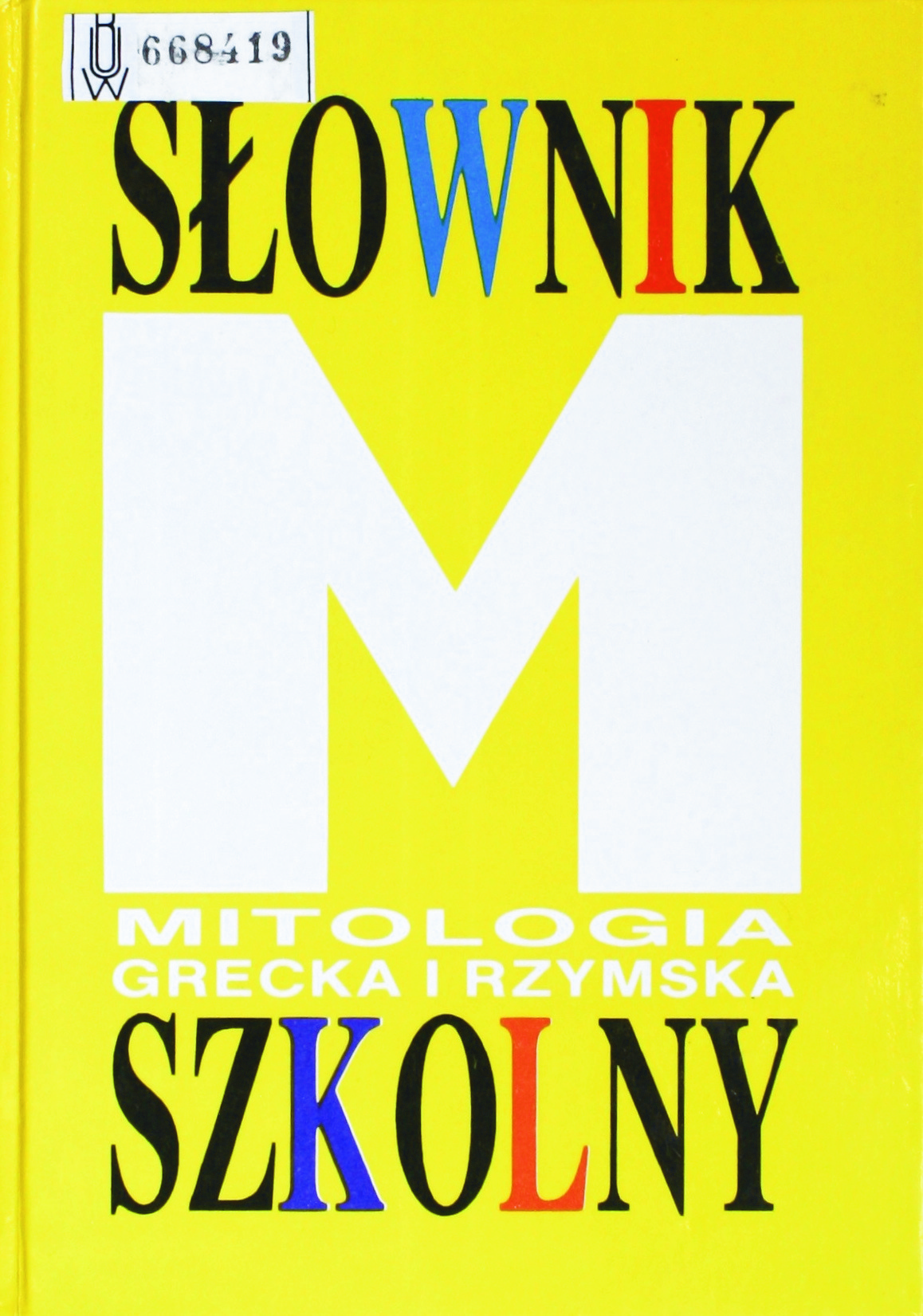Title of the work
Country of the First Edition
Country/countries of popularity
Original Language
First Edition Date
First Edition Details
Stanisław Stabryła, Słownik szkolny. Mitologia grecka i rzymska. Warszawa: Wydawnictwa Szkolne i Pedagogiczne, 1994, 224 pp.
ISBN
Genre
Glossary
Myths
Target Audience
Children (school children)
Cover

Courtesy of the publisher.
Author of the Entry:
Summary: Katarzyna Sendecka, University of Warsaw, katarzyna.sendecka@student.uw.edu.pl
Analysis: Marta Pszczolińska, University of Warsaw, m.pszczolinska@al.uw.edu.pl
Peer-reviewer of the Entry:
Katarzyna Marciniak, University of Warsaw, kamar@al.uw.edu.pl
Elżbieta Olechowska, University of Warsaw, elzbieta.olechowska@gmail.com

Photograph courtesy of the Author.
Stanisław Stabryła
, b. 1936
(Author)
Classical philologist, retired professor of the Jagiellonian University. Author of numerous publications on ancient culture and Latin literature of the Augustan Age. His scholarly interests encompass Roman and Christian literature and the reception of Antiquity in Polish literature. His most notable and popular works include: Hellada i Roma w Polsce Ludowej. Recepcja antyku w literaturze polskiej w latach 1945–1975 [Hellada and Roma in the People’s Republic of Poland. Reception of Antiquity in Polish Literature Between 1945 and 1975], 1983; Mitologia dla dorosłych [Mythology for Grown-ups], 1995; Klątwa Pelopidów [The Curse of the Pelopids], 1995; Hellada i Roma. Recepcja antyku w literaturze polskiej w latach 1976–1990 [Hellada and Roma. Reception of Antiquity in Polish Literature Between 1976 and 1990], 1996; Księga legend rzymskich [The Book of Roman Legends], 1998; Dzieje wojny trojańskiej [The History of the Trojan War], 2004, and Terroryści znad Tybru [Terrorists from the Tiber’s Shores], 2006. Translator of ancient texts such as Seneca’s Thoughts or Ovid’s Metamorphoses (translated with Anna Kamieńska). Member of Polska Akademia Umiejętności [Polish Academy of Arts and Sciences], Polski PEN Club [Polish PEN Club] and Polskie Towarzystwo Filologiczne [Polish Philological Society].
Sources:
[The Author’s Website], (accessed: March 14, 2013).
"Wspomnienia profesora Stanisława Stabryły", http://www.archiwum.uj.edu. pl/stanislaw-stabryla (accessed: March 14, 2013).
Bio prepared by Katarzyna Sendecka, University of Warsaw, katarzyna.sendecka@student.uw.edu.pl
Sequels, Prequels and Spin-offs
Stanisław Stabryła, Mały leksykon mitologii greckiej i rzymskiej, Kraków: Wydawnictwo Edukacyjne, 2006, 365 pp.
Summary
Based on: Katarzyna Marciniak, Elżbieta Olechowska, Joanna Kłos, Michał Kucharski (eds.), Polish Literature for Children & Young Adults Inspired by Classical Antiquity: A Catalogue, Faculty of “Artes Liberales”, Warsaw: University of Warsaw, 2013, 444 pp.
In this dictionary, alphabetically ordered entries take school children on a journey through Greek and Roman mythology. Accessibly written descriptions, mainly of gods and heroes, present adaptions of the most important myths and ancient anecdotes. He opts for versions of myths generally accepted by scholars, except particularly long and complex stories. In such cases, he briefly introduces other existing versions, often referring to sources. This format provides children with a good first impression of mythology without overwhelming them with myriad interpretations. One hundred thirty black-and-white sketches by Barbara Opoka illustrate and liven up an otherwise standard glossary style, ensuring an easier and more enjoyable reading experience for children. These sketches allow children a glimpse of mythological events and familiarize them with ancient art: sculptures or bas-reliefs, as well as vase painting. The book is aimed specifically at younger school children but can also serve as a reference for adolescents.
Analysis
The publication is the first modern Polish lexicon of Greek and Roman mythology, though many valuable textbooks about mythology also exist. The main goal of the publication was to create a guide for young readers, facilitating the study of literature and art history, where the presence of mythological characters is evident. Though the dictionary has not been written for an academic purpose, the author’s deep and thorough knowledge of Greek and Roman mythology makes it an appropriate resource for school readers and useful for other audiences.
The dictionary combines scientific information based on reliable sources with an accessible, clear composition and illustrations, enriching the text with images of ancient art. Each entry provides information about the names of mythological characters (their Greek or Latin forms if different than in Polish, in some cases their etymology) and their genealogy. The cults and/or festivals of Greek gods and heroes and their Roman counterparts are also discussed. Equally valuable as the ancient “who is who” are the concluding segments of each entry listing ancient and modern literary, musical (operas) and other works of art related to mythological characters. This part can be considered very useful as it shows the continuous presence of particular characters or mythical tales in the European culture through the ages. The text is full of references to other related entries, which can satisfy readers’ curiosity and extend their knowledge. There are no separate entries about Roman deities. The names appear only as equivalents to the Greek names (e.g., Hercules → Heracles, Luna → Selene). Some minor characters are included (e.g., Calaïs → Boreads, Castor → Dioscuri, Clotho → Moirai).
Although Greek mythology is replete with sex and violence, such incidents are often omitted or glossed over in consideration for younger audiences. Still, the author, relying on ancient sources, treats his young readers seriously and presents subplots negatively affecting the selected character’s honour. The myth of Heracles provides a good example. While the author does not mention Linus’ manslaughter or Thespius’ daughters’ story, as they are of minor relevance, he openly admits that Heracles murders his wife (Megara) and children in a bout of madness. This part of the myth is key in understanding why the hero served Eurystheus.
Further Reading
Gärtner, Hans, August Friedrich von Pauly, Walther Sontheimer, Konrat Ziegler, eds., Der Kleine Pauly. Lexikon der Antike, München: Druckenmüller, 1964–1975.
Grimal, Pierre, The Concise Dictionary of Classical Mythology, ed. Stephen Kershaw, trans. A. R. Maxwell-Hyslop, Basil Blackwell Ltd, 1990.
Stabryła, Stanisław, “The Classical Culture in the Modern World”, Classica Cracoviensia 18 (2021): 349–362 (accessed: December 9, 2021).
Styka, Jerzy, “Musarum cultor. Stanisław Stabryła: uczony, humanista, człowiek”, in Jerzy Styka, ed., From Antiquity to Modern Times. Classical Poetry and its Modern Reception. Essays in honour of Stanislaw Stabryla, Kraków: Księgarnia Akademicka, 2007.
Addenda
Cover, title page: Wiesław Pawlak.
Illustrations (based on ancient works of art): Barbara Opoka.


